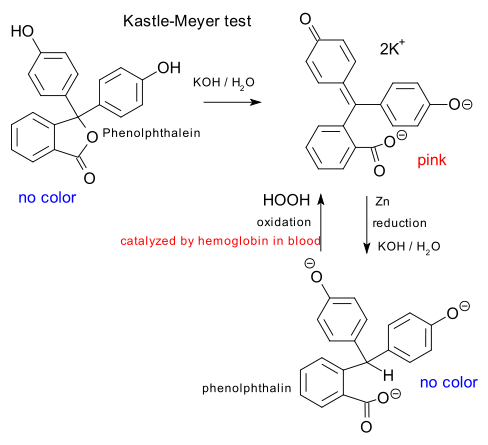CSI in trouble
18 November 2008 - News
Members of any CSI team never venture anywhere without their Kastle-Meyer solution to probe for traces of blood. Although generally considered a reliable test (sensitivity 1 in 100,000), researchers have found a way to tamper with the evidence (DOI). It turns out that cleaning up any crime scene (by villains) with any modern detergent containing so-called active oxygen makes any blood probing reagent useless.

A colorless Kastle-Meyer solution contains the reduced form of phenolphthalein called phenolphthalin which reacts with hydrogen peroxide back to pink phenolphthalein. Significantly this reaction is catalysed by hemoglobin present in blood making it a chemical test for blood itself.
The researches have found that cleaning a blood sample containing an active oxygen component, more specifically sodium perchlorate results in negatives with this test. To make matters worse, two other methods, one using luminol and another using an Immunoassay technique called Hexagon OBTI (Link) also fail miserably. And the really interesting part is that the researchers do not have a clue why this is.
So until they find out why and even better find a way to fix it forensically speaking, picture yourself this scene from CSI: Miami where finally the show's star David Caruso bites the dust. As you may know, every episode, David has his villain in sight within 5 minutes not based on any evidence but solely on the level of the villain's arrogance. The next 45 minutes of the show is spent on the tedium bore of collecting that evidence.
David: I dont like your face , I know you committed the murder, and you did it over there !
Villan: you will never find the evidence !
David: Oh yeah, try cleaning up the mess all you like but have you never heard of Kastle & Meyer !
Villan: Oh yeah, haven't you yet read Naturwissenschaften volume 95 page 1432 !
David: ehhhhh......
-------
Ana Castelló, Francesc Francès, Dolores Corella, Fernando Verdú (2008). Active oxygen doctors the evidence Naturwissenschaften DOI: 10.1007/s00114-008-0466-9
